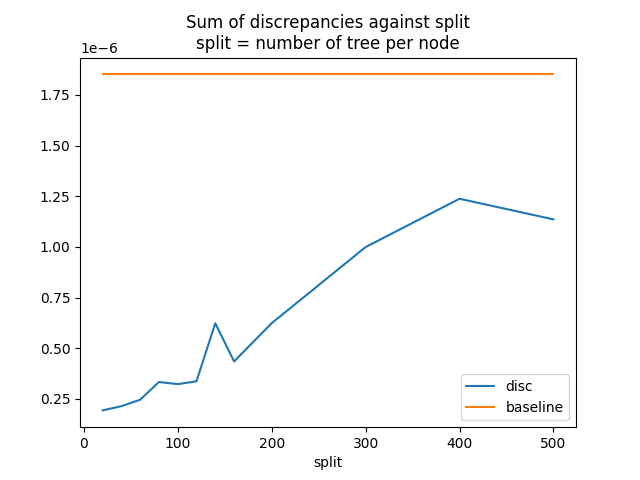Note
Click here to download the full example code
Convert a pipeline with a LightGBM regressor¶
The discrepancies observed when using float and TreeEnsemble operator (see Issues when switching to float) explains why the converter for LGBMRegressor may introduce significant discrepancies even when it is used with float tensors.
Library lightgbm is implemented with double. A random forest regressor
with multiple trees computes its prediction by adding the prediction of
every tree. After being converting into ONNX, this summation becomes
,
where F is the number of trees in the forest,
the output of tree i and
a float addition. The discrepancy can be expressed as
.
This grows with the number of trees in the forest.
To reduce the impact, an option was added to split the node
TreeEnsembleRegressor into multiple ones and to do a summation
with double this time. If we assume the node if split into a nodes,
the discrepancies then become
.
Train a LGBMRegressor¶
from distutils.version import StrictVersion
import warnings
import timeit
import numpy
from pandas import DataFrame
# import matplotlib.pyplot as plt
from tqdm import tqdm
from lightgbm import LGBMRegressor
from onnxruntime import InferenceSession
from skl2onnx import to_onnx, update_registered_converter
from skl2onnx.common.shape_calculator import calculate_linear_regressor_output_shapes # noqa
from onnxmltools import __version__ as oml_version
from onnxmltools.convert.lightgbm.operator_converters.LightGbm import convert_lightgbm # noqa
N = 1000
X = numpy.random.randn(N, 20)
y = (numpy.random.randn(N) +
numpy.random.randn(N) * 100 * numpy.random.randint(0, 1, 1000))
reg = LGBMRegressor(n_estimators=1000)
reg.fit(X, y)
Out:
LGBMRegressor(n_estimators=1000)
Register the converter for LGBMClassifier¶
The converter is implemented in onnxmltools: onnxmltools…LightGbm.py. and the shape calculator: onnxmltools…Regressor.py.
def skl2onnx_convert_lightgbm(scope, operator, container):
options = scope.get_options(operator.raw_operator)
if 'split' in options:
if StrictVersion(oml_version) < StrictVersion('1.9.2'):
warnings.warn(
"Option split was released in version 1.9.2 but %s is "
"installed. It will be ignored." % oml_version)
operator.split = options['split']
else:
operator.split = None
convert_lightgbm(scope, operator, container)
update_registered_converter(
LGBMRegressor, 'LightGbmLGBMRegressor',
calculate_linear_regressor_output_shapes,
skl2onnx_convert_lightgbm,
options={'split': None})
Convert¶
We convert the same model following the two scenarios, one single TreeEnsembleRegressor node, or more. split parameter is the number of trees per node TreeEnsembleRegressor.
model_onnx = to_onnx(reg, X[:1].astype(numpy.float32),
target_opset={'': 14, 'ai.onnx.ml': 2})
model_onnx_split = to_onnx(reg, X[:1].astype(numpy.float32),
target_opset={'': 14, 'ai.onnx.ml': 2},
options={'split': 100})
Out:
/var/lib/jenkins/workspace/onnxcustom/onnxcustom_UT_39_std/_doc/examples/plot_gexternal_lightgbm_reg.py:78: DeprecationWarning: distutils Version classes are deprecated. Use packaging.version instead.
if StrictVersion(oml_version) < StrictVersion('1.9.2'):
Discrepancies¶
sess = InferenceSession(model_onnx.SerializeToString(),
providers=['CPUExecutionProvider'])
sess_split = InferenceSession(model_onnx_split.SerializeToString(),
providers=['CPUExecutionProvider'])
X32 = X.astype(numpy.float32)
expected = reg.predict(X32)
got = sess.run(None, {'X': X32})[0].ravel()
got_split = sess_split.run(None, {'X': X32})[0].ravel()
disp = numpy.abs(got - expected).sum()
disp_split = numpy.abs(got_split - expected).sum()
print("sum of discrepancies 1 node", disp)
print("sum of discrepancies split node",
disp_split, "ratio:", disp / disp_split)
Out:
sum of discrepancies 1 node 0.00021465639434970537
sum of discrepancies split node 4.253979806128228e-05 ratio: 5.046013477555163
The sum of the discrepancies were reduced 4, 5 times. The maximum is much better too.
disc = numpy.abs(got - expected).max()
disc_split = numpy.abs(got_split - expected).max()
print("max discrepancies 1 node", disc)
print("max discrepancies split node", disc_split, "ratio:", disc / disc_split)
Out:
max discrepancies 1 node 1.85114812856213e-06
max discrepancies split node 3.228950369305039e-07 ratio: 5.732971761224528
Processing time¶
The processing time is slower but not much.
print("processing time no split",
timeit.timeit(
lambda: sess.run(None, {'X': X32})[0], number=150))
print("processing time split",
timeit.timeit(
lambda: sess_split.run(None, {'X': X32})[0], number=150))
Out:
processing time no split 3.6881782775744796
processing time split 3.6407719487324357
Split influence¶
Let’s see how the sum of the discrepancies moves against the parameter split.
res = []
for i in tqdm(list(range(20, 170, 20)) + [200, 300, 400, 500]):
model_onnx_split = to_onnx(reg, X[:1].astype(numpy.float32),
target_opset={'': 14, 'ai.onnx.ml': 2},
options={'split': i})
sess_split = InferenceSession(model_onnx_split.SerializeToString(),
providers=['CPUExecutionProvider'])
got_split = sess_split.run(None, {'X': X32})[0].ravel()
disc_split = numpy.abs(got_split - expected).max()
res.append(dict(split=i, disc=disc_split))
df = DataFrame(res).set_index('split')
df["baseline"] = disc
print(df)
Out:
0%| | 0/12 [00:00<?, ?it/s]/var/lib/jenkins/workspace/onnxcustom/onnxcustom_UT_39_std/_doc/examples/plot_gexternal_lightgbm_reg.py:78: DeprecationWarning: distutils Version classes are deprecated. Use packaging.version instead.
if StrictVersion(oml_version) < StrictVersion('1.9.2'):
8%|8 | 1/12 [00:14<02:38, 14.38s/it]
17%|#6 | 2/12 [00:27<02:15, 13.55s/it]
25%|##5 | 3/12 [00:40<01:58, 13.18s/it]
33%|###3 | 4/12 [00:52<01:43, 12.94s/it]
42%|####1 | 5/12 [01:05<01:30, 12.98s/it]
50%|##### | 6/12 [01:18<01:16, 12.80s/it]
58%|#####8 | 7/12 [01:30<01:03, 12.68s/it]
67%|######6 | 8/12 [01:43<00:51, 12.78s/it]
75%|#######5 | 9/12 [01:55<00:37, 12.64s/it]
83%|########3 | 10/12 [02:08<00:25, 12.55s/it]
92%|#########1| 11/12 [02:21<00:12, 12.69s/it]
100%|##########| 12/12 [02:33<00:00, 12.58s/it]
100%|##########| 12/12 [02:33<00:00, 12.80s/it]
disc baseline
split
20 1.932818e-07 0.000002
40 2.141412e-07 0.000002
60 2.458757e-07 0.000002
80 3.333199e-07 0.000002
100 3.228950e-07 0.000002
120 3.369252e-07 0.000002
140 6.233323e-07 0.000002
160 4.348161e-07 0.000002
200 6.233323e-07 0.000002
300 9.991299e-07 0.000002
400 1.237549e-06 0.000002
500 1.135892e-06 0.000002
Graph.
ax = df.plot(title="Sum of discrepancies against split\n"
"split = number of tree per node")
# plt.show()

Total running time of the script: ( 3 minutes 8.918 seconds)